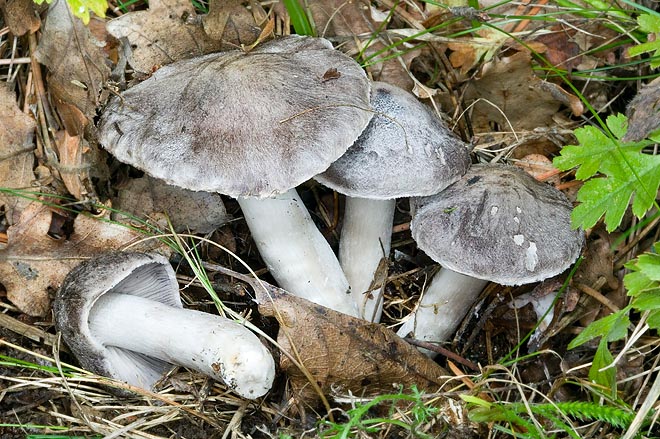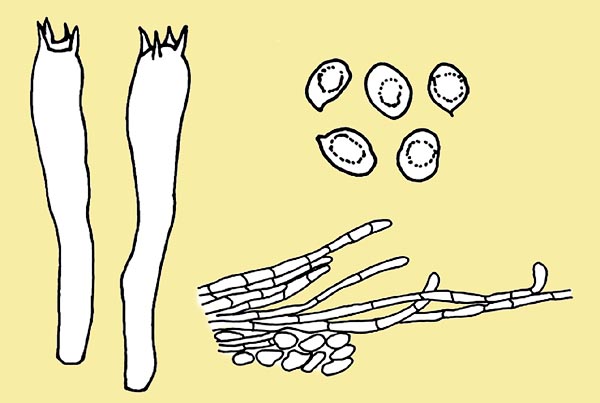
Text © Pierluigi Angeli

English translation by Mario Beltramini

Tricholoma terreum is excellent, frail raw but firm and crispy if cooked © Giuseppe Mazza
Family: Tricholomataceae R. Heim ex Pouzar, 1983.
Genus: Tricholoma (Fries) Staude, 1857.
Section: Atrosquamosa Kühner emend. Bon.
Subsection: Terrea.
Stirpe: Terreum.
Tricholoma terreum (Schaeff. : Fr.) Kumm., 1871.
The term terreum comes from the Latin “térreus” = earthy, relevant to the earth.
It is a well known and sought for species, in some zones, even commercialized. In Italy, it is known with the popular names of “moretta”, “fratino”, bigello”, “cavarese”; in France, “tricholome couleur de souris”, “charbonnier”, “petit gris”, “Tricholome terreux”; in Spain: in Catalan, “fredolic”, “brunet”; in Castilian, “negrilla”; in Euskara, “ziza arre”; in Aragonese, “morrico de corzo”; in Germany, “Gemeine Erd-Ritterling”; in UK, “grey agaric”, “grey knight”, “dirty tricholoma”.
For the description of the Genus, please refer to Tricholoma columbetta.
Descriptions of the Section, Subsection and Stirpe
Belong to the Section Atrosquamosa small or medium sized fungi, with felty cuticle, fibrillose-woolly, silky, with brown or blackish little scales, whitish, grey brownish, even with yellowish shades, slightly protruding. The stipe is cylindraceous and slender, in some cases fistulose, smooth or fibrillose, furfuraceous, at times with remnants of temporary veil, in some cases adorned with scales, only one species is ringed. The flesh is mainly white, usually immutable, smell farinaceous, sub-farinaceous, at times aromatic or almost definable; the taste is good, mild, peppery, sourish, at times, even unpleasant.
The Subsection Terrea includes small fungi, having mostly a convex cap, or flattened-convex, not or little umbonate; velvety, felted, woolly-felted, flaky or scaly surface, of white, grey, grey-blackish colour. Whitish stipe, with remnants of grey cortiniform veil or at times well visible as ring. Flesh always mild.
The Stirpe Terreum includes small fungi with felted surface of the cap, velvety, woolly-felted, of grey colour, or mouse-grey, grey-brownish or grey-blackish. Smooth stipe, just fibrillose, with temporary veil remnants, often fistulose, and whitish.

Tricholoma terreum basidia, spores and pileipellis © Pierluigi Angeli
Description of the species
Cap: 3-5 (8) cm, initially hemispheric, campanulate, then convex and finally flattened and a little sinuate, with umbo at times obtuse, at times more attenuated; inrolled margin, then only curved with cuticle rolling inward on the gills, regular. Felted cuticle, fibrillose-woolly, uniform, of mouse-grey, smoky grey, darker at the centre, colour.
Hymenium: averagely thick gills, wide, emarginated and decurrent for a tooth, with regular thread, intercalated by lamellulas of unequal length, white at the beginning, then greyish when ripe.
Stipe: 4-8 × 1-1,5 cm, cylindraceous, slightly attenuated below, full then fistulose, frail, smooth, silky, without trace of partial veil, white, also with grey hues.
Flesh: rather meagre, frail, fibrous in the stipe, white, greyish under the cuticle in the mature specimens. The smell is almost zero, but not of flour, mild taste.
Habitat: it grows in summer and in full autumn, in conifer woods, in much numerous groups.
Edibility: excellent edible, frail when raw but firm and crispy when cooked.
Microscopy. Spores: ellipsoidal, globose, smooth, 6-8 × 4-5 µm. Basidia: clavate, tetrasporic, without joint buckles, 29-36 × 6,5-7,5 µm. Epicutis: formed by fairly short lying hyphae.
Remarks. It is a very well known mushroom and sought for the consumption, as the numerous common names state. It is often mistaken with the Tricholoma myomyces (Pers. : Fr.) Lge., which, however, has the remnants of the cortiniform veil high on the stipe, slight smell of flour and is smaller; the Tricholoma gausapatum (Fr. : Fr.) Quél., which, however, has more spaced gills, the stipe off-white and remnants of the cortiniform veil on the stipe, at least in the young specimens, the smell of flour is slight; another possible confusion may be done with the Tricholoma triste (Scop. : Fr.) Quél., which however has the lower part of the stipe with blackish fibrillaes, the lamellar thread dark and the smell herbaceous; the Tricholoma cingulatum (Almf. In Fr.) Jacobasch, which, however, has the surface with more evident little scales, woolly ring and slight smell of flour.
Synonyms: Agaricus terreus Schaeff. 1762 (basionym); Agaricus pullus Batsch 1783; Tricholoma bisporigerum J.E. Lange 1933.
→ For general notions about Fungi please click here.
→ To appreciate the biodiversity of MUSHROOMS please click here.
